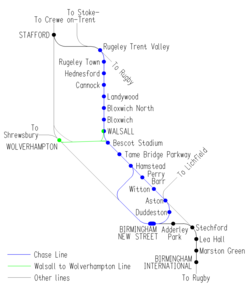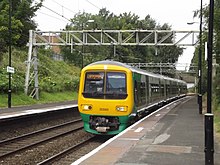Chase Line
| Chase Line | |
|---|---|
 Map of the Chase Line. Not to scale. | |
| Overview | |
| Status | Operational |
| Owner | Network Rail |
| Locale | Staffordshire West Midlands West Midlands (region) |
| Stations | 15 |
| Service | |
| Type | Suburban rail, Heavy rail |
| System | National Rail |
| Technical | |
| Track gauge | 1,435 mm (4 ft 8+1⁄2 in) standard gauge |
Chase Line | ||||||||||||||||||||||||||||||||||||||||||||||||||||||||||||||||||||||||||||||||||||||||||||||||||||||||||||||||||||||||||||||||||||||||||||||||||||||||||||||||||||||||||||||||||||||||||||||||||||||||||||||||||||||||||||||||||||||||||||||||||||||||||||||||||||||||||||||||||||||||||||||||||||||||||||||||||||||||||||||||||||||||||
|---|---|---|---|---|---|---|---|---|---|---|---|---|---|---|---|---|---|---|---|---|---|---|---|---|---|---|---|---|---|---|---|---|---|---|---|---|---|---|---|---|---|---|---|---|---|---|---|---|---|---|---|---|---|---|---|---|---|---|---|---|---|---|---|---|---|---|---|---|---|---|---|---|---|---|---|---|---|---|---|---|---|---|---|---|---|---|---|---|---|---|---|---|---|---|---|---|---|---|---|---|---|---|---|---|---|---|---|---|---|---|---|---|---|---|---|---|---|---|---|---|---|---|---|---|---|---|---|---|---|---|---|---|---|---|---|---|---|---|---|---|---|---|---|---|---|---|---|---|---|---|---|---|---|---|---|---|---|---|---|---|---|---|---|---|---|---|---|---|---|---|---|---|---|---|---|---|---|---|---|---|---|---|---|---|---|---|---|---|---|---|---|---|---|---|---|---|---|---|---|---|---|---|---|---|---|---|---|---|---|---|---|---|---|---|---|---|---|---|---|---|---|---|---|---|---|---|---|---|---|---|---|---|---|---|---|---|---|---|---|---|---|---|---|---|---|---|---|---|---|---|---|---|---|---|---|---|---|---|---|---|---|---|---|---|---|---|---|---|---|---|---|---|---|---|---|---|---|---|---|---|---|---|---|---|---|---|---|---|---|---|---|---|---|---|---|---|---|---|---|---|---|---|---|---|---|---|---|---|---|---|---|---|---|---|---|---|---|---|---|---|---|---|---|---|---|---|---|---|---|---|
| ||||||||||||||||||||||||||||||||||||||||||||||||||||||||||||||||||||||||||||||||||||||||||||||||||||||||||||||||||||||||||||||||||||||||||||||||||||||||||||||||||||||||||||||||||||||||||||||||||||||||||||||||||||||||||||||||||||||||||||||||||||||||||||||||||||||||||||||||||||||||||||||||||||||||||||||||||||||||||||||||||||||||||
The Chase Line is a suburban railway line in the West Midlands region of England. It runs from its southern terminus, Birmingham New Street, to Walsall, and then Rugeley in Staffordshire, where it joins the Trent Valley Line. The name of the line refers to Cannock Chase which it runs through at its northern end.
Part of the line between Birmingham and Walsall has been electrified since the 1960s, work is currently underway to electrify the remaining 15 mile stretch of line between Walsall and Rugeley, which is scheduled for completion by December 2017.[1]
Overview
The line from Birmingham to Walsall (sometimes referred to as the Walsall Line) has two alternative routes, both electrified at 25 kV AC overhead. One leaves New Street to the east, following the Cross-City Line as far as Aston, where it diverges to the west. The other leaves to the west, and travels via Soho. Beyond Walsall, the line is not electrified, and continues north to Hednesford and Rugeley. This section was freight-only, and reopened to passenger trains in stages between 1989 and 1998.
Places served on the route are listed below. For information on the stations, please refer to the list in the route map.
Chase Line (Walsall-Rugeley)
- Rugeley
- Hednesford
- Cannock
- Great Wyrley (closed in 1964)
- Landywood
- Bloxwich
- Walsall
Walsall Line (Birmingham-Walsall)
- Walsall
- Bescot (for Bescot Stadium, the home of Walsall FC)
- Stone Cross (near Tame Bridge Parkway station)
- Hamstead
- Perry Barr
- Witton
- Aston
- Duddeston
- Birmingham New Street (Interchange For Grand Central)
- Services then continue onwards to Wolverhampton via the Rugby–Birmingham–Stafford Line.
Passenger trains are operated by London Midland on behalf of Transport for West Midlands.
Services

Monday to Saturday daytime there are four trains per hour from Birmingham New Street to Walsall. Two per hour run via Aston and call at all stations, the other two per hour run direct via Soho and call at Tame Bridge Parkway and Walsall. Two of these per-hour continue to Rugeley Trent Valley during peak hours, dropping to one per-hour off peak.[2]
Monday to Saturday evenings and all day Sunday there are two trains per hour (one stopping and one semi-fast) between Walsall and Birmingham and an hourly service to Rugeley Trent Valley.
Class 323 Electric Multiple Units are used for services on the electrified section between Birmingham and Walsall. The services which continue beyond Walsall on the non-electrified stretch to Rugeley use Class 170 Diesel Multiple Units.Some services also utilise Class 153 units in partnership with the Class 170's.
Two daily services operate between Walsall and Liverpool Lime Street.
History
- The line from Birmingham via Aston, Perry Barr and Bescot was opened in 1837 as part of one of the earliest railway main lines; the Grand Junction Railway (GJR). This line did not serve Walsall directly, but continued from Bescot to Wolverhampton (this is now part of the Walsall to Wolverhampton Line). A station on the GJR called Walsall was opened on the outskirts of the town, this was later renamed Wood Green, and is now closed. The GJR became part of the London and North Western Railway (LNWR) in 1846.[3]
- The section through Walsall, including the present Walsall station was opened in 1849 by the South Staffordshire Railway, as part of their (now closed) South Staffordshire Line from Dudley to Wychnor Junction, north of Lichfield, a connection was opened from Walsall to the GJR at Bescot, allowing direct Walsall-Birmingham trains.[3]
- The section between Walsall and Rugeley Trent Valley was constructed by the South Staffordshire Railway, and the Cannock Mineral Railway (CMR): The South Staffordshire Railway built the line from Walsall to Cannock, opening in 1858, and the CMR built the line from Cannock to Rugeley, opening in 1859. The South Staffordshire Railway was absorbed by the LNWR in 1867, as was the CMR two years later.[3]
- The last part of what is now the Walsall/Chase Line, the Soho Loop Line; a link between the original GJR and the Stour Valley Line, allowing an alternative route into Birmingham which bypassed Aston, was opened by the LNWR in 1889. Two stations were opened on this line; Soho Road and Handsworth Wood, both were closed in 1941.[3]
Reopening
The line between Walsall and Rugeley Trent Valley closed to passengers in 1965, remaining open to freight, although until the 1980s it was not unknown for diverted Inter-City passenger services from Birmingham to Manchester, Edinburgh, Glasgow, etc. to use the line in the event of the Wolverhampton-Stafford route being shut for Sunday or late evening engineering work.[4] It reopened in stages, as follows:[5]
- 10 April 1989 — Walsall to Hednesford
- 2 June 1997 — Hednesford to Rugeley Town
- 25 May 1998 — Rugeley Town to Rugeley Trent Valley and Stafford
- 12 December 2008 — Chase Line trains are cut back from Stafford to Rugeley Trent Valley.
Electrification
The lines between New Street and Walsall were electrified in 1966 as an offshoot of the West Coast Main Line electrification, along with the Walsall to Wolverhampton Line.[6]
In July 2012, the coalition government announced the overhead electrification of the Chase Line between Rugeley Trent Valley and Walsall, with work scheduled to take place from 2014, with an estimated completion date of December 2017.[7] It is estimated to cost around £36m, as part of a £9.4bn package of investment in the railways in England and Wales, including £4.2bn of new schemes, unveiled by the government. The electrification was first discussed in the early 1960s, but funding was secured by Aidan Burley, MP for Cannock Chase in February 2013 after his Adjournment Debate on 14 June 2012.[8]
The electrification of the line will be accompanied by a speed increase from the current 45 mph to 75 mph. Bloxwich level crossing will be closed to motorised traffic, the bridge at Central Drive north of the crossing being strengthened and widened to improve the alternative route. This will enable the current 20 mph speed limit to be lifted. It will also enable the line to transport W10 freight containers. Preliminary work to re-signal the route ahead of electrification was completed in August 2013, with the closure of the three remaining manual signal boxes at Bloxwich, Hednesford & Brereton Sidings and the panel boxes at Walsall & Bescot. Control of the area passed to the West Midlands SCC at Saltley.
For residents of the area, the changes will mean up to 15 minutes shorter journey times [9] and reduced overcrowding to Birmingham with 4 trains per hour (tph), as well as the introduction of new services to Birmingham International (2tph), Coventry (2tph), Liverpool Lime Street and even the possibility of a direct service to London Euston.[10] The electrification itself will create over 1300 jobs in the area and generate a further £113 million of gross value added (GVA) benefit per annum, as well as reducing the operating costs of the line.
In May 2014, London Midland announced that it was intending to run longer trains[11] on the route, requiring station platforms to be extended to accommodate.
Controversy over electrification
Gavin Williamson, Conservative MP for South Staffordshire, has campaigned to limit the speed of trains through Great Wyrley and Cheslyn Hay when the upgrade work of the line is complete. He has written to transport secretary Patrick McLoughlin, requesting confirmation that trains travelling through these areas will not exceed a speed of 45 mph.[12] He has also requested that "environmental mitigation measures" be put in place to reduce the potential impact of the electrification on residents in South Staffordshire. Network Rail had previously said that electric trains are quieter, greener and cleaner, reducing carbon emissions.[13]
References
- ^ "Chase Line Electrification on target for completion". Cannock Chase Council. Retrieved 10 September 2016.
- ^ GB National Rail Timetable 2015-16 Edition, Table 70R (Network Rail)
- ^ a b c d Boynton, John (1996). Rails Around Walsall. Mid England Books. ISBN 0-9522248-3-6.
- ^ J. Glover, West Midlands Rails in the 1980s, Ian Allan, 1984
- ^ Boynton, John. A Century of Railways around Birmingham and the West Midlands, Volume Three 1973-1999. Mid England Books. ISBN 0-9522248-6-0.
- ^ British Railways Engineering 1948-80" by John Johnson and Robert A. Long (Mechanical Engineering Publications Ltd, 1981
- ^ "Chase Line Electrification on target for completion". Cannock Chase Council. 1 December 2015. Retrieved 16 June 2016.
- ^ Debate: Walsall-Rugeley Line (Electrification)
- ^ High speed rail and supporting investments in the West Midlands Archived 2014-08-12 at the Wayback Machine
- ^ "£30m to improve Midlands train link". Express & Star. Retrieved 15 February 2013.
- ^ More seats on trains after £30m Chase Line work
- ^ Gavin Williamson MP meets with the under secretary of state over speed of trains through Great Wyrley and Cheslyn Hay
- ^ Network rail announcement for the Chase Line upgrade
- A Century of Railways Around Birmingham and the West Midlands, Volume 3 1973-1999, John Boynton.
- Quail Railway Track Diagrams, Volume 4: Midlands & North West (ISBN 0-9549866-0-1)

